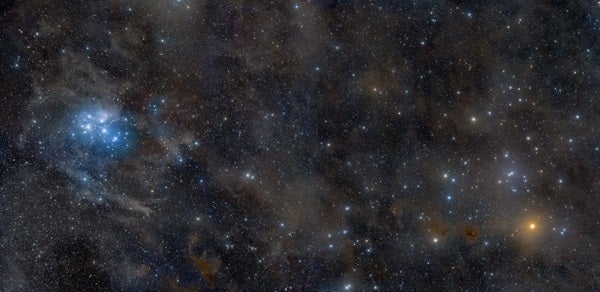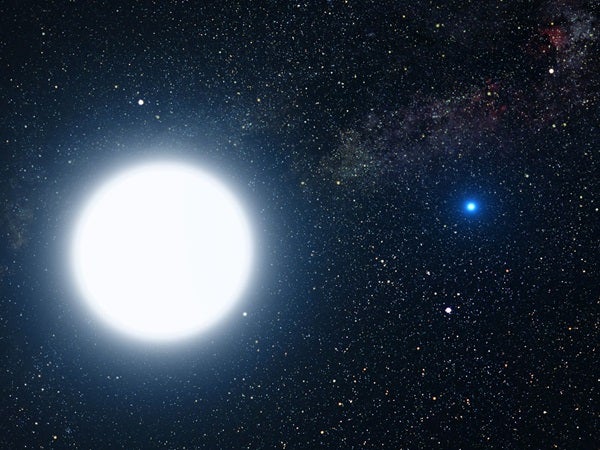February evenings offer a great opportunity to view the zodiacal light. From the Northern Hemisphere, late winter and early spring are the best times of year to observe this elusive glow after sunset. It appears slightly fainter than the Milky Way, so you’ll need a clear moonless sky and an observing site located far from the city. The waxing crescent Moon returns to the evening sky on February 17, so you’ll want to look for the cone-shaped glow before then. The zodiacal light has a broad base that points nearly straight up from the western horizon once the last vestiges of twilight have faded away.
Saturday, February 10
Mars passes 5° due north of Antares this morning. Although the Red Planet officially lies in the southwestern corner of the constellation Ophiuchus, it appears in a single binocular field with Scorpius’ brightest star. Because both Mars and Antares shine at magnitude 1.1, this is a perfect opportunity to compare the colors of the two objects, and come to understand why ancient observers named the star Antares, which literally means “rival of Mars.” Unfortunately, the view of Mars through a telescope proves disappointing — its disk spans only 6″ and shows no detail.
Sunday, February 11
The waning crescent Moon appears 2° above Saturn this morning. The two rise shortly after 4 a.m. local time and climb some 10° above the southeastern horizon by the time twilight starts. The planet shines at magnitude 0.6 and appears significantly brighter than any of the background stars in its host constellation, Sagittarius the Archer.
The Moon reaches apogee, the farthest point in its orbit around Earth, at 9:16 a.m. EST. It then lies 252,090 miles (405,700 kilometers) from Earth’s center.
Monday, February 12
A pair of fine binocular objects are on display tonight. The open star clusters M46 and M47 reside about a degree apart in the northwestern corner of the constellation Puppis the Stern. The two lie about 12° east-northeast of the sky’s brightest star, Sirius. The western cluster, M47, glows at 4th magnitude and appears as a fuzzy patch sprinkled with several pinpoint stars. Sixth-magnitude M46 shows up as a hazy collection of faint stars that is hard to resolve under most conditions. Although it contains nearly twice as many stars as M47, M46 appears fainter and fuzzier because it lies some three times farther from Earth.
Tuesday, February 13
Head outside before dawn and you can’t miss Jupiter. The giant planet rises shortly before 1 a.m. local time and climbs 30° high in the south by the time twilight commences. Jupiter shines at magnitude –2.1, which makes it the brightest point of light in the night sky, and resides among the much dimmer stars of the constellation Libra. A telescope reveals the planet’s 37″-diameter disk.
This false-color rendering of Ceres shows the variation in the dwarf planet’s surface composition. The bright spots may be related to salts, such as hydrated magnesium sulfate.
NASA/JPL-Caltech/UCLA/MPS/DLR/IDA
Wednesday, February 14
The dwarf planet Ceres reached opposition and peak visibility in late January, and it remains a fine sight this month. It currently shines at magnitude 7.0 and is an easy object to spot through binoculars. The largest member of the asteroid belt resides in the northern part of the constellation Cancer the Crab, which appears in the east once darkness falls and climbs highest in the south around 11 p.m. local time. This evening, Ceres lies 0.9° south-southwest of the 5th-magnitude star Sigma3 (σ3) Cancri.
Thursday, February 15
New Moon occurs at 4:05 p.m. EST. At its New phase, the Moon crosses the sky with the Sun and so remains hidden in our star’s glare. At least, it typically does. But if you live in the right area, today you can watch the Moon pass in front of the Sun and cause a partial solar eclipse. Observers in most of Chile, Argentina, and Uruguay will have front-row seats. The best sites are at the southern tip of South America, where the Moon covers 35 percent of the Sun’s diameter at maximum. Remember that when viewing the Sun during a partial eclipse, protect your eyes by using a safe solar filter.
This is a good week to look for Sirius in the evening sky. The night sky’s brightest star (at magnitude –1.5) appears due south and at its highest position around 9 p.m. local time. It then lies about one-third of the way from the horizon to the zenith from mid-northern latitudes. (The farther south you live, the higher it appears.) If you point binoculars at Sirius, look for the pretty star cluster M41 in the same field of view, just 4° below the star.
Saturday, February 17
Although the Moon reached its New phase just two days ago, its rapid orbital motion carries it into view after the Sun goes down this evening. Look low in the west-southwest about an hour after sunset and you’ll see its 4-percent-lit crescent hanging in the twilight like the smile of the Cheshire Cat.
Mercury reaches superior conjunction at 7 a.m. EST. This means the innermost planet lies on the opposite side of the Sun from Earth and remains hidden in our star’s glare. It will return to view in the evening sky in late February.
Sunday, February 18
Two of the finest deep-sky objects shine prominently on February evenings. The Pleiades and Hyades star clusters appear highest in the south as darkness falls but remain conspicuous until well past midnight. The Pleiades, also known at the Seven Sisters and M45, looks like a small dipper to naked eyes. The larger Hyades forms the V-shaped head of Taurus the Bull. Although both look nice with naked eyes, binoculars show them best.











